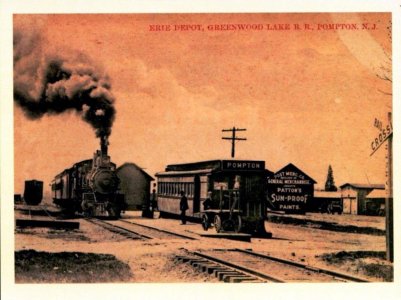The New York and Greenwood Lake Railway disappeared in the late 1920s due to reservoir being built across a major part of its ROW. The railroad its self at one point became a subsidiary of the Erie Railroad who operated the railroad on the cheap with light rails and older equipment. At the moment I'm working on a project to bring the route back to life with a bit of artistic license and what ifs since so much is gone. During the research phase, a friend of mine for whom I'm making the route for, has been digging through some photos that belonged to is grandfather who worked for the NYGWL Rwy. and later the Erie.
Among these fabulously fascinating photos, is this station down at Pompton, NJ where the line crossed the New York Susquehanna and Western, also an Erie subsidiary at the time. Today, Pompton Jct. still exists and still pretty much intact. The line north ends about 1/2 mile past the jct. and serves as a small spur to serve a junk yard. The line south ends a bit down towards Pompton Lakes as a spur. This line has been mothballed, and will probably be turned into a rail trail, but hopefully not.
Anyway, here's the Pompton jct. station.

Yes, the station is an old passenger car with a door cut into the side of it. How cool is that! The Erie steam locomotive is something as well.
Among these fabulously fascinating photos, is this station down at Pompton, NJ where the line crossed the New York Susquehanna and Western, also an Erie subsidiary at the time. Today, Pompton Jct. still exists and still pretty much intact. The line north ends about 1/2 mile past the jct. and serves as a small spur to serve a junk yard. The line south ends a bit down towards Pompton Lakes as a spur. This line has been mothballed, and will probably be turned into a rail trail, but hopefully not.
Anyway, here's the Pompton jct. station.

Yes, the station is an old passenger car with a door cut into the side of it. How cool is that! The Erie steam locomotive is something as well.
